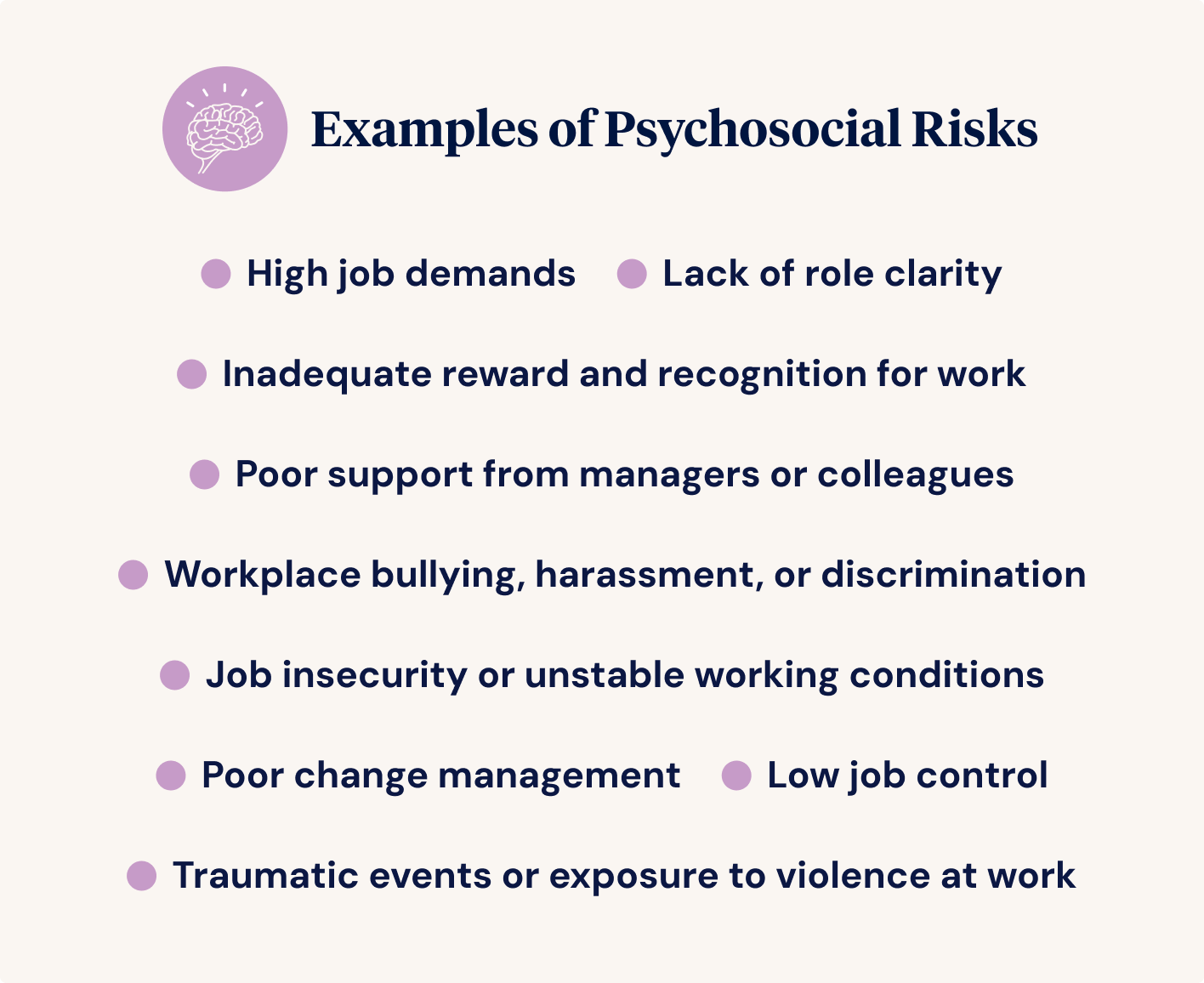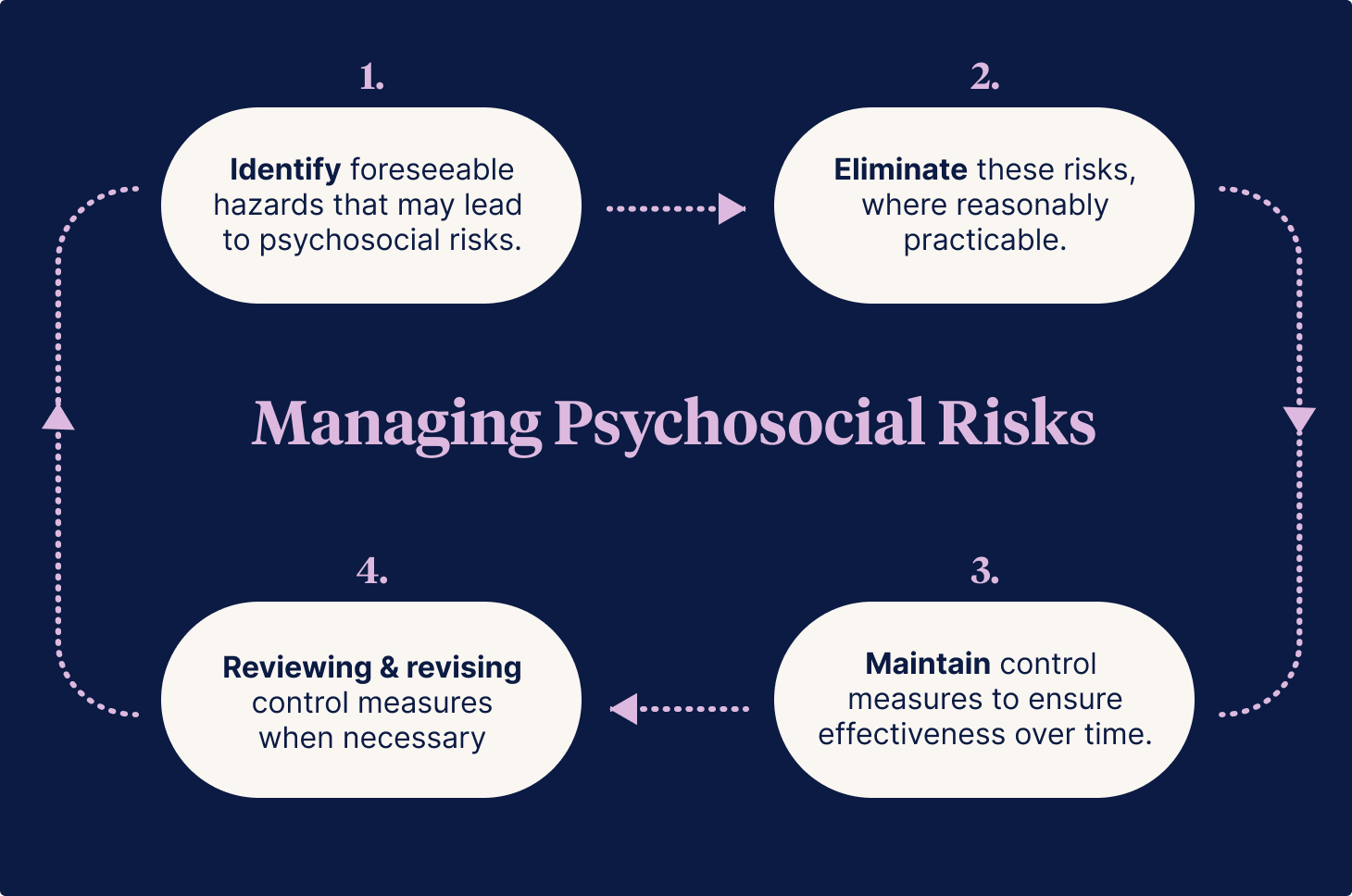Psychological safety is vital for high-performing workplaces. With my background in law and as the founder of Talked, I’ve seen how it helps employees feel supported and confident to speak up, boosting engagement and creativity. In Australia, it’s both a necessity and a legal responsibility.
Australian work health and safety (WHS) laws now explicitly require businesses to identify, eliminate, or manage psychosocial risks as part of their broader duty to provide a safe workplace. This guide outlines your obligations as leaders when it comes to managing psychological safety.
Why Psychological Safety Matters
Effective psychological safety initiatives deliver significant advantages in both wellbeing and performance. Psychological safety is like a safety net, it catches employees when they struggle and fall. It provides an environment where they have the confidence to take risks, speak up, and admit when things aren’t working. Without it, fear takes over, and creativity and openness get shut down.
According to the Australian Institute of Health and Welfare, around one in five Australian workers has experienced a mental health condition in the past 12 months. Meanwhile, the Australian Bureau of Statistics indicates that nearly half (45%) of Australians will face a mental health issue at some point in their lives.
This prevalence comes with a hefty price tag. Research from Safe Work Australia estimated that at the cost of level levels of psychological safety is estimated to cost a minimum of AUD$6 billion per year. Whether through absenteeism, diminished productivity, or compensation claims, the cost of psychological safety is not to be ignored.
The Legal and Regulatory Background
Significant amendments to Commonwealth work health and safety laws were introduced in April 2023, requiring employers to address hazards and risks affecting workers’ psychological health. For the first time, the Work Health and Safety Regulations 2011 outline specific steps employers must take to identify and manage these psychological health and safety risks.
As a result, each state and territory clarified their model codes of practice and how they require businesses to address psychological safety.
Overview of State and Territory Requirements
The following table outlines each state and territory’s Work Health and Safety (WHS) regulator, the relevant legislation, and the applicable model code of practice for managing psychosocial hazards at work:
| State | Regulatory Body | Legislation | Model Code of Practice |
|---|---|---|---|
| NSW | SafeWork NSW | Work Health and Safety Regulation 2017 | Model Code of Practice 2022 |
| QLD | WorkSafe QLD | Work Health and Safety (Psychosocial Risks) Amendment Regulation 2022 | Managing the risk of psychosocial hazards at work Code of Practice 2022 |
| WA | Worksafe Commissioner | Work Health and Safety Act 2020 | Code of practice Psychosocial Hazards in the workplace |
| SA | SafeWorkSA | Work Health and Safety (Psychosocial Risks) Amendment Regulations 2023
under Work Health and Safety Act 2012 |
Aligned with the Safework Australia Code of Practice |
| TAS | Worksafe Tasmania | The Work Health and Safety Regulations 2022 | Aligned with the Safework Australia Code of Practice |
| VIC | WorkSafe VIC | Occupational Health and Safety Act 2004 | Not yet announced - regulation to be announced by 1 December 2025 |
| NT | NT Worksafe | Work Health and Safety Regulations 2011 | Aligned with the Safework Australia Code of Practice |
| ACT | WorkSafe ACT | Work Health and Safety (Managing Psychosocial Hazards at Work Code of Practice) Approval 2023 made under the
Work Health and Safety Act 2011 |
Managing
Psychosocial Hazards at Work Code of Practice August 2023 |
Impact on Organisations and Leaders
As a business or a leader within an organisation, you are now obligated to address psychosocial hazards in the workplace.
Your duty is to eliminate psychosocial risks or if that is not reasonably practicable, to reduce them as much as possible.
What is a Psychosocial Risk?
Psychosocial risks or hazards refer to aspects of work design, management, and organisation – as well as the social context of work – that have the potential to cause psychological or physical harm (Safe Work Australia, n.d)
In simpler terms, they are work-related factors that can affect a person’s mental health and wellbeing.
Examples of psychosocial risks include:
- High job demands (e.g., unmanageable workloads or unrealistic deadlines)
- Low job control (e.g., little say over how work is done)
- Poor support from managers or colleagues
- Workplace bullying, harassment, or discrimination
- Poor organisational change management
- Traumatic events or exposure to violence at work
- Lack of role clarity (e.g., confusion about job expectations)
- Job insecurity or unstable working conditions
- Inadequate reward and recognition for work
Read more about each psychosocial hazard and how to identify and mitigate the hazard at Safe Work Australia.

Impact of Psychosocial Risks
Psychosocial hazards can interact or combine, leading to new, altered, or increased risks. When managing psychosocial risks, it is important to consider all potential hazards that workers may be exposed to.
If psychosocial risks are not properly managed, they can lead to:
- Stress, anxiety, depression, or burnout
- Poorer physical health outcomes (e.g., cardiovascular issues)
- Increased absenteeism and presenteeism
- Higher turnover rates
- Reduced productivity and engagement
- Workplace injuries (e.g., from fatigue or distraction)

Managing Psychosocial Risks
Under the WHS Regulations, managing psychosocial risks involves the following steps:
- Identifying reasonably foreseeable hazards that may lead to psychosocial risks.
- Eliminating these risks, where reasonably practicable.
- Maintaining control measures to ensure they remain effective over time.
- Reviewing and revising control measures when necessary to uphold, as far as practicable, a work environment free of health and safety risks.

Leaders set the tone for establishing a culture that values and proactively manages psychological safety. Practical strategies include:
- Championing mental health initiatives.
- Aligning HR strategies to support psychological wellbeing.
- Promoting EAP (Employee Assistance Programme) utilisation through providers like Talked.
- Training future leaders in empathy, active listening, and accountability.
Regular 360-degree feedback, providing safe spaces for mistakes, and encouraging honest discussions are all practices that cultivate a thriving, psychologically safe workplace.
How Employees Proactively Participate
Employees play a key role in maintaining psychological safety by treating colleagues with respect, reporting bullying or harassment, and encouraging open communication. Those feeling overwhelmed or uncertain about their roles should feel confident to raise concerns, whether informally with managers or through formal processes. By actively contributing ideas, identifying inefficiencies, and suggesting improvements, employees can help address issues early. A culture of collaboration and mutual respect ensures psychological safety and shared accountability for a positive workplace environment.
Conclusion
In today’s regulatory landscape, psychological safety is both a legal necessity and a strategic advantage. It safeguards employee wellbeing while fostering innovation, collaboration, and growth. Actions like offering flexible work options, improving reporting systems, and investing in leadership development can drive lasting impact.
Now is the time for you to take the lead. Update your policies, engage with your workforce, and provide the right training and resources. By prioritising psychological safety, you’ll meet legal requirements, strengthen your business, and create a thriving workplace for all.
Learn More About Building Safer, Stronger Workplaces
Explore more resources and practical training from Ausmed:
- Building a Resilient Workforce
- How to Minimise Burnout
- Speak up for Patient Safety
- The Power of Empathy
- Introduction to Occupational Health and Safety (OHS)
- Identify Stress and Vicarious, Secondary, Indirect Trauma in Nurses
- Mental Health and Productivity - Is There a Link?
- Guide to Employee Wellbeing: Legal Perspective for Leaders
- Navigating the Right Skill Mix
- The Impact of Social Connections on Novice Nurses
References
- Report on Australia’s mental health system - Australian Institue of Health and Welfare
- Report on the cost of psychological safety - Safe Work Australia
- Laws and regulations of WHS - Safe Work Australia
Author
Vincent Lau
Vincent Lau is the Co-Founder and Head of Operations at Talked, Australia's leading online mental health and psychology platform. With a background in corporate law, Vincent brings a unique perspective on how Australians engage with mental health services. He is passionate about delivering consumer-centric care and improving access to mental health support.
Leveraging his expertise in strategy development, project management, and thought leadership, Vincent drives impactful change both at Talked and within the community, focusing on creating positive outcomes for all patients.



